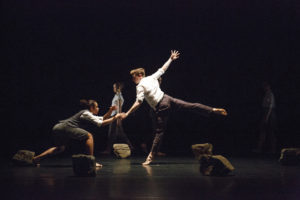
By Rebecca Karpus
While many factors have contributed to the success of Toronto’s 42-year-old Canadian Contemporary Dance Theatre, one of the youth company’s greatest advantages is its robust foundation in Limón modern dance technique. Its creator, José Limón, who immigrated to the United States from Mexico as a child, is considered one of the most influential choreographers of the 20th century. Although Limón died some time ago, in 1972, the New York City-based Limón Dance Company is still active today.

When Deborah Lundmark co-founded Canadian Contemporary Dance Theatre, she strived to replicate a professional contemporary dance environment for children. Lundmark believed a modern technique would provide a strong foundation for her dancers, and soon a Limón teacher by the name of Donna Krasnow became an integral part of the company.
Krasnow, professor emerita at Toronto’s York University, had learned Limón through Daniel Lewis, a dancer in the Limón company at a time when the master was still at the helm. Entrusted with building a Limón curriculum for CCDT dancers ages seven to 19, Krasnow began by “deconstructing” Lewis’ model, asking herself over and over, “What is the fundamental thing this exercise is trying to do?” Her goal was to build a syllabus supporting “progressive accumulative development.”

Many of Limón’s principles actually relate to the innate movement of children, such as swinging motions and falling to the ground. Krasnow explains that, unlike Graham technique, whose quintessential contraction motion is developmentally difficult for children, the essence of Limón is more readily captured by the young body. Applying her expertise in dance science research, she explains that Limón principles, including the use of breath, weight, rebound, fall and recovery, isolation, succession, and suspension, contribute to sound body alignment.
The technique’s natural quality goes hand in hand with the “humanist tradition” in Limón’s choreography, in which he often explored themes relating to the human condition. His technique was created to teach his own dancers the principles underlying his choreographic works, and Krasnow often adds excerpts of Limón’s repertoire to her classes.
Colin Connor, a former artistic director of the Limón company, believes that Limón brings out a sense of individualism and self-expression. “It’s a technique where you improve your understanding of how you use your body, but it’s also one where you become more yourself so it feels like ‘you’ dancing,” he shares. Leaning into this, Krasnow has worked improvisation into all levels of her curriculum, allowing students to “explore Limón ideas in their own movement vocabulary.”

Another key feature of Limón’s work is his “theatrically really effective” use of space, Connor says. In addition to focusing on the internal experience, the technique actively works “in relation to what’s on the outside,” like the air, the floor, and the other dancers. As a choreographer whose own work is informed by Limón, Connor appreciates Limón’s ability to choreograph with an acute awareness of these outside elements and believes it results in a sophisticated understanding of physical space. Krasnow agrees that Limón’s work is “spatially magnificent,” and believes that it was partly shaped by his background in visual art.
As Limón valued musicality, the use of music is also significant in Krasnow’s curriculum. Since 1987, she has collaborated with pianist Craig Ziebarth. She admires Ziebarth’s understanding of syncopation, how he might play a circular six-count instead of an expected waltz during an exercise, and how he “peaks where a lot of musicians drop back down, which allows for that extended suspension.” In order to embody the contrasting lightness and heaviness that sometimes occurs within Limón movement, Ziebarth might play a high melody on the right side of the piano keys while simultaneously playing deep low keys on the left.
CCDT alumnus Nicholas Ruscica, who is a dancer with the Limón company, tries to carve out time to travel back to Toronto to teach at CCDT, where, he says, he received “the best standard of Limón training for any young person.” Because it is built on so many elements that come naturally to the body, Ruscica believes that “Limón technique, even if you don’t practice it, exists within.”
Today, CCDT dancers train in Limón technique, Royal Academy of Dance ballet, and other modern and contemporary styles by guest teachers. The company holds an annual summer program in conjunction with the School of CCDT. Lundmark, who teaches RAD ballet herself, still feels passionately about Limón technique and what it has to offer young dancers. Although she does not teach Limón herself, she says, “I have it in my soul.”

